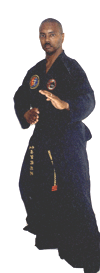

|
|
|
When we use the term JuJitsu, Ninjitsu, Karate, Taekwondo, Aikido etc... to describe the martial art we practice, I wonder how many of us realize just how wide its applications actually are. First introduce into the Martial arts by his father Sensei Griffin has over 32 years of experience. In my earlier days of training, I trained hard and enjoyed the vigor and power that go with youthful practice, performing techniques the strength and speed. Now I find that I approach those same techniques in a totally different way, looking for an economy of movement that produces the maximum effect from a minimal expenditure of energy. What I am trying to say is that there is not only a wide variety of techniques in Jujitsu, Ninjitsu, Aikido etc.. but also a number of different ways to performing those same techniques. This is the why JuJitsu, NinJitsu techniques work equally well for the fit young tiger and the slight or older (Dragon) person. So, work hard at what you are doing and don't be in a great hurry to pass on to the next technique, because this is the behavior of a shallow person and not of a martial artist. Though I have been training for a long period, I still don't think I can perform every technique perfectly. It is necessary for me to keep on practicing them. If you want to know more about your technique, try teaching it to someone else! You have to break it down, identify the key points and present those points in a way that is easily understood. Doing this gives you a very good insight into technique and the way it works. I mention this only because many people would rather learn Jujitsu, Ninjitsu than teach others, yet by teaching others, you come to learn more about the arts yourself! When
I look back over the long history of Jujitsu, Ninjitsu, I see that
its origins interpenetrate just about every other far Many martial arts today teach techniques and nothing more. Students eventually become masters of techniques but when age catches up with them their once perfect technique begins to fail and they are left with nothing. Yet it seems obvious to me that martial arts practice involves so much more than just learning how to throw someone this way, or how to hold someone that way. First of all, it requires patience and persistence - for the path of martial arts is not an easy one to follow. Secondly, it involves a true humility, which comes about only through self-knowledge. By all means be moderately please with yourself for attaining the standard you hold - but never be envious or contemptuous of others' standards. The third requirement of a martial artist is to have an inquiring mind that analyses what is being taught. Don't be content merely to copy - understand as well! Knowledge allows you to develop your practice. The Koga Ryu Ninjitsu studies Jujitsu in all its forms and refuses to take any narrower path. Because of this, it is my proud boast that we can teach Jujitsu to anyone. I sincerely hope that this will be a foundation for you throughout your Jujitsu career. Sensei Griffin |

 eastern martial art that you care to mention. For example, the Southern
Shaolin Boxer Chin Gempin (the Japanese reading of his name) taught
kung fu techniques to samurai already skilled in JuJitsu. The techniques
of swordplay (Kenjitsu) required the warrior to be able to close
and disarm the opponent. The ancient histories of Sumo and Jujitsu
are so closely interlinked that I question anyone to prove which
came from what? The infamous Ninja mercenaries incorporated Jujitsu
techniques in their own fighting system (Ninjitsu). The founders
of Aikido and shorinji kempo were both Jujitsu masters. A teacher
of Jujitsu founded on the four major schools of karate and that
style remains unique in it usage of body movement and concurrent
techniques. In fact, I would contend that every Japanese martial
art (Bujitsu) contains element of JuJitsu. This diversity of background
had and does lead to problems nowadays, because of the modern tendency
to separate the various martial arts into discrete disciplines.
Thus the modern student practices Jujitsu and, perhaps, kendo as
tow separate activities, whereas traditionally they were inseparable.
I oppose the modern segregation and the Jujitsu /Ninjitsu, which
I teach, aims to restore the classic approach. This is why you will
discover sword techniques, weapons work, striking techniques and
all manner of other practices which today one does not normally
associate with JuJitsu practice. A 'style' is a particular schools
way of practicing a martial art. I regard it, as the narrowing down
of the wide field of practice to suit one individual's (the founder's)
preferences. For though I may be capable of performing a certain
series of techniques really well, there is no reason why my students
should be able to perform those same techniques with equal ease.
They may lack the necessary power, or agility. Should I tell the
blind student that he/she couldn't practice my style because it
is designed only for those with sight? Is it not my aim - as a Sensei
to extend the practice of Jujitsu / Ninjitsu rather that to limit
it by rigid adherence to a style? What happens if my style uses
lots of high kicks and older students with inflexible hips want
to take part?
eastern martial art that you care to mention. For example, the Southern
Shaolin Boxer Chin Gempin (the Japanese reading of his name) taught
kung fu techniques to samurai already skilled in JuJitsu. The techniques
of swordplay (Kenjitsu) required the warrior to be able to close
and disarm the opponent. The ancient histories of Sumo and Jujitsu
are so closely interlinked that I question anyone to prove which
came from what? The infamous Ninja mercenaries incorporated Jujitsu
techniques in their own fighting system (Ninjitsu). The founders
of Aikido and shorinji kempo were both Jujitsu masters. A teacher
of Jujitsu founded on the four major schools of karate and that
style remains unique in it usage of body movement and concurrent
techniques. In fact, I would contend that every Japanese martial
art (Bujitsu) contains element of JuJitsu. This diversity of background
had and does lead to problems nowadays, because of the modern tendency
to separate the various martial arts into discrete disciplines.
Thus the modern student practices Jujitsu and, perhaps, kendo as
tow separate activities, whereas traditionally they were inseparable.
I oppose the modern segregation and the Jujitsu /Ninjitsu, which
I teach, aims to restore the classic approach. This is why you will
discover sword techniques, weapons work, striking techniques and
all manner of other practices which today one does not normally
associate with JuJitsu practice. A 'style' is a particular schools
way of practicing a martial art. I regard it, as the narrowing down
of the wide field of practice to suit one individual's (the founder's)
preferences. For though I may be capable of performing a certain
series of techniques really well, there is no reason why my students
should be able to perform those same techniques with equal ease.
They may lack the necessary power, or agility. Should I tell the
blind student that he/she couldn't practice my style because it
is designed only for those with sight? Is it not my aim - as a Sensei
to extend the practice of Jujitsu / Ninjitsu rather that to limit
it by rigid adherence to a style? What happens if my style uses
lots of high kicks and older students with inflexible hips want
to take part?